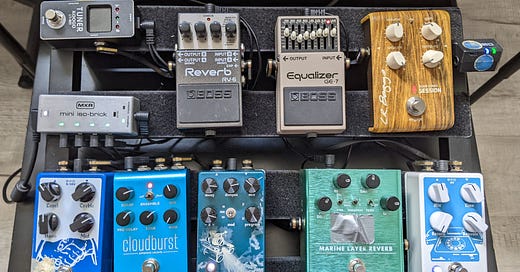As promised, here is a brief explanation of my large pedalboard from my previous post. If you are totally new to the world of electric violin playing, you may wonder why I need pedals and hence, a pedalboard? (A pedalboard is a board that contains a bunch of sound effects pedals linked together in a sequence to change the sound from the instrument). The picture of the board is shown below. These mini-sound effects boxes are called pedals, probably because you can turn them on by your foot!
The reasons for pedals. An electric violin is different from a regular acoustic violin in that it needs to be plugged in (via an instrument cable) to an amp (or speakers) for people to adequately hear its sound. If you play an electric violin by itself then you will only hear a tiny sound, much like if you played an electric guitar unplugged. So, at home, starting out, you just need an electric violin, a cable, and an amp, right?
Yes, you can produce an adequate volume of sound with just an electric violin and an amp, (you need to pick out the right amp too, but that is for another post!) but the sound of the electric violin will be very “dry” and “harsh” if you do not add in any sound effects through either effects pedals or the effects available in the amp.
Due to the lack of understanding about the need to add pedals to the electric violin, many people probably got frustrated and quit playing the electric violin just after a couple sessions, because the electric violin sounded much worse than their regular acoustic violin! You can play electric guitar going straight into an amp, and have it sound decent, but not so for the electric violin. Adding sound effects are absolutely necessary for the electric violin. I would not play the electric violin myself if I don’t at least run it through a reverb pedal (which is the most important pedal for the electric violin).
A pricy amp may have 3-4 effects built in that you can add on to your sound (such as EQ, Reverb, Delay, and Chorus), but the range and quality of those effects on the amp itself will never be as good running the sound through separate pedals (dedicated Delay pedal, Reverb pedal, etc.) This is why each individual pedals may cost $100-400 each!
In my big board pictured above I have 9 pedals plus the MXR Mini-Iso Brick which is the power source supplying power to the pedals. I am not running all 9 pedals at once, but using a different mixture of pedals from song to song to get the right sound that I want for the violin. The last pedal before the sound goes to the amp is the tuner pedal (I use it to tune my violin, I only have it on when tuning). Most people have the tuner pedal as the first pedal in the “signal chain” (the direction the sound is traveling through). I will go over the sequence of pedal placement in a future post.
On this board I have 4 different brands of reverb pedals (Marine Layer, Fathom, Cloudburst, and Boss RV-6 Reverb). Each one producing different types and colors of reverbs. All other effects I have one of each. This shows you the importance of the reverb effect to my sound. Sometimes I use one reverb pedal at a time and sometimes I combine 2 reverbs together. What works best I learn from years of experimentation (trial and error). When I get a new pedal, there are usually tweakable parameters in the pedal itself (different knobs on the pedal) that it takes me at least 6 months to figure out to “play” the pedal. In short, you “figure out” the pedal so you know exactly which knob to turn (how much vs how little) to produce the desired sound.
I use the analogy of cooking a food dish. A pedal is one ingredient in the recipe. How much of the ingredient to add is how much amount of the effect is used from the pedal. When you have too much or too little of the ingredient the dish will taste bad. It is the same with sound. Too much effect or too little effect will ruin the sound. A beginner with pedals will generally use too much effects. Part of the fun with using a pedalboard is finding the right amount of effects for each pedal, adding up to generate a super pleasing sound as the end result.
In future posts, I will go over in detail the function of each type of pedals and how it pertains to the electric violin. Plus more demo videos.
Sam




